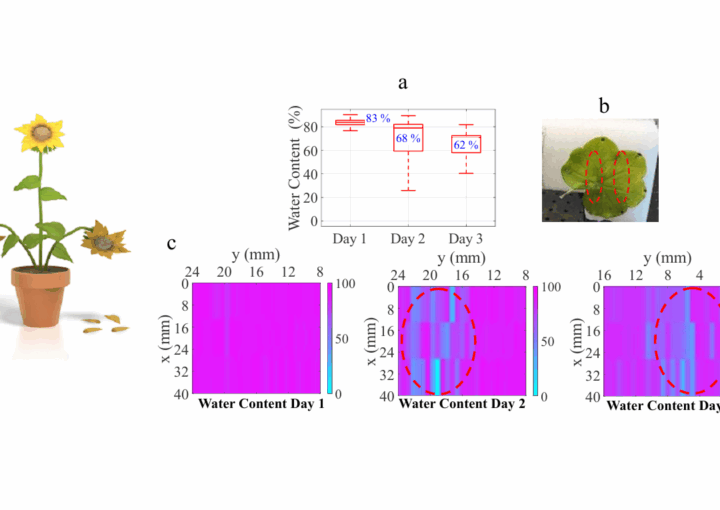
Current non-contact plant monitoring focuses on water content in precision agriculture—but terahertz.NRW takes it further. Operating in the 0.2–5 THz range, we use bio-functionalized THz sensors, agile radar imaging with SiGe BiCMOS, nearfield scanning, and non-linear tomography to provide a full picture of plant health.
Our THz monitoring systems enable precise water and nutrient dosing with the world’s smallest THz transceivers, made from InP Resonant Tunneling Diodes (RTD) and specialized InP transistors. Designed for rugged conditions, they’re compact, energy-efficient, and network-ready for off-grid use.
We also track root growth, pest damage, and heavy metal accumulation in real-time while studying plant interactions with pollinators and pests. With THz radar imaging, we monitor pollinators’ flight patterns and blossom visits, detecting their unique radar-cross-section (RCS).
Our research explores how aphids, mites, and pests respond to heavy-metal contaminated plants, using high-resolution THz insect monitoring. We also study honey bee energy uptake under 6G and THz exposure, comparing results to ICNIRP safety limits with virtual dosimetry and digital twins in experiments—pushing the boundaries of innovation in environmental monitoring.
Miniaturized, energy-efficient THz sensors precisely capture the condition of plants and their water and nutrient content using highly miniaturized THz radar transceivers, which can be attached to plant leaves over characteristic growth periods. In this context, the accumulation of heavy metals in the leaves of the model plant A. thaliana can also be examined in more detail. An interesting field of research here is the nonlinear mm-wave/THz tomography for analyzing the growth kinetics of root topologies as a function of nutrient supplements, e.g. in indoor farming.
Using THz radar imaging, the ecosystem around plants is examined: flight patterns of specific pollinators (e.g. bees) and the movements of tiny pests such as aphids and spider mites. The focus is on their interaction in the biome immediately around model plants such as A. halleri and the heavy metal-accumulating A. thaliana. Of particular interest here are the heavy metal-dependent pest feeding and the variations in flight kinetics as a function of possible environmental stressors. Another field of research is the absorption of electromagnetic radiation (i.e. electromagnetic microdosimetry) in bees and other arthropods at mm-waves/THz frequencies.
The in-situ monitoring of the transport processes of nutrients in plant stems, for example as part of a life cycle and growth analysis on model plants, is the focus of the investigations here. These are carried out with the help of electromagnetic THz near-field scanning probes or by taking into account the electromagnetic scattering, which is detected by azimuthally arranged THz transceiver arrays. An innovative approach here is the use of appropriately functionalized THz near-field sensor array chips, which can map growth and transport processes in micrometer resolution and in real time.
The research aims at sustainable water and nutrient dosing in the context of smart farming, whereby resources can be used more efficiently. This makes THz radar imaging and THz sensor technology powerful tools for precision agriculture. The latter also includes compact, chemically functionalized, microfluidic-based THz sensors for detecting microorganisms, pathogens in aerosols and environmental gases. The radical miniaturization at THz frequencies also enables remotely readable, telemetrically localizable THz sensor platforms that can be applied to airborne microflyers to collect spatially resolved environmental data.
Adding {{itemName}} to cart
Added {{itemName}} to cart